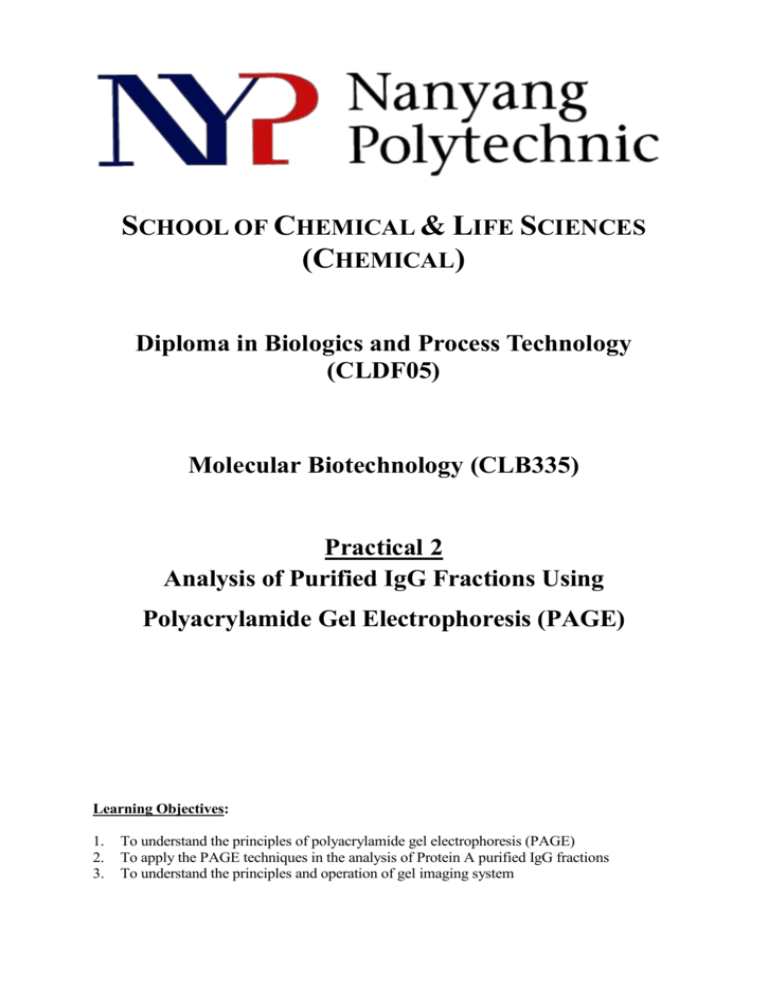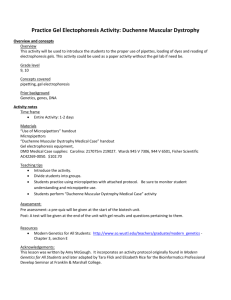
SCHOOL OF CHEMICAL & LIFE SCIENCES
(CHEMICAL)
Diploma in Biologics and Process Technology
(CLDF05)
Molecular Biotechnology (CLB335)
Practical 2
Analysis of Purified IgG Fractions Using
Polyacrylamide Gel Electrophoresis (PAGE)
Learning Objectives:
1.
2.
3.
To understand the principles of polyacrylamide gel electrophoresis (PAGE)
To apply the PAGE techniques in the analysis of Protein A purified IgG fractions
To understand the principles and operation of gel imaging system
Bioprocess Applications CLx202
Introduction
Gel Electrophoresis is a method commonly used to obtain important information on the
molecular weight, charges and purity of biomolecules. It is based on the separation of the
molecules in an inert matrix when an electric field is applied. The matrix (also known as the
gel) is a cross-linked polymer that acts as molecular sieves with its network of pores, and
smaller molecules generally move faster through the gel compared to larger ones.
Sodium dodecyl sulfate-polyacrylamide gel electrophoresis (SDS-PAGE) is commonly used
for the analysis of proteins, particularly for the monitoring of fractions obtained from
chromatographic purifications. It involves the use of SDS (a detergent) to disrupt protein
folding and linearize the proteins into their constituent polypeptide chain. The SDS also coats
the linearized proteins with negative charges proportional to their length which allows the
separation to be based on their molecular weight.
The sample is typically loaded together with a tracking dye (Bromophenol blue) that allows
the run to be monitored. On completion of the run, the gel containing the separated proteins
can be stained with anionic dyes such as Coomassie Brilliant Blue R-250 in order to visualize
the bands. The stained gels can then be transferred onto a membrane using Western blotting
techniques or viewed directly using a gel imaging system.
Materials
1.
Amersham ECL Precast Gel 12%, 10 wells
2.
Amersham ECL Horizontal Gel Electrophoresis System
3.
10x SDS-Tris-Glycine buffer
4.
PageRuler Plus Prestained Protein Ladder, 10 to 250kDa
5.
2x Laemmli Buffer
6.
Bio-Rad Bio-Safe Coomassie Stain
7.
Odyssey® Fc Imager
Practical 1
Page 2 of 5
Copyright © Nanyang Polytechnic. All Rights Reserved.
Last Update: 08 Jan 2012
Bioprocess Applications CLx202
Procedures
A. Preparation of Gel
1.
Prepare 1x running buffer by diluting 20ml of 10x SDS-Tris-glycine in 180ml of
deionized water.
2.
Add 90 ml of 1x running buffer to each tank of Amersham ECL Gel Box.
3.
Cut open the gel package and gently remove Amersham ECL Gel from the package.
4.
Rinse the gel cassette with deionized water and peel off the tapes from the two legs
of the cassette.
5.
Place Amersham ECL Gel in Amersham ECL Gel Box so that the well side of the
cassette faces toward the cathode and the other cassette leg faces toward the anode.
6.
Pipette around 2ml of the 1x running buffer into the wells and place the safety lid on
top of the Amersham ECL Gel Box.
7.
Connect Amersham ECL Gel Box to the power supply (EPS 301) and pre-run the
gel for 12 minutes at 160 V. Proceed to the preparation of samples while waiting for
the pre-run to complete.
8.
Once the pre-run is finished, switch off the power and remove the safety lid.
B. Preparation of Sample for Gel Electrophoresis
1.
Using the absorbance readings obtained from the SpectraMax® M3 microplate
reader in the previous week, identify the fractions most likely to contain the rabbit
IgG. Perform a 10x dilution of the identified fractions by pipetting 10μl of the
sample into 90μl of the running buffer.
2.
Prepare the sample for loading by pipetting 10μl of the diluted sample into 10μl of
2x Laemmli buffer.
3.
Spin down the samples quickly in a microcentrifuge before incubating the samples
in a digital heat bath at 95°C for 5 minutes.
4.
Spin down the samples again before loading them directly into the wells of the gel.
C. Loading of Samples for Gel Electrophoresis
1.
Check that the power supply is switched off before loading the samples.
2.
Load 10μl of the prestained protein ladder into the first well from the left.
3.
Load the rest of the samples into each well of the gel.
Note: Any empty well should be loaded with the loading buffer to prevent the
sample lanes from spreading out.
D. Running of SDS-PAGE
1.
Once all the samples have been loaded, run the gel at 160V. The run can be
monitored by observing the tracking dye as it moves through the gel. The bands of
the prestained protein ladder should also become more visible as the run proceeds.
2.
Allow the run to proceed until the blue tracking dye from the sample buffer has
reaches the end of the gel.
3.
Switch off the power supply at the end of the run.
Practical 1
Page 3 of 5
Copyright © Nanyang Polytechnic. All Rights Reserved.
Last Update: 08 Jan 2012
Bioprocess Applications CLx202
E. Staining & Destaining of the Gel
1.
At the end of the run, proceed to remove the gel from the cassette for staining.
2.
Remove the gel cassette from the gel box and twist open the cassette using the edge
of the comb.
3.
Remove the top plate from the gel cassette and allow the gel to sit on the bottom
plate.
4.
Cut away the stacking gel (approximately 2 cm downstream of the wells) with the
end of the top plate.
5.
Use the edge of the top plate to gently push the gel until it is removed from the
cassette.
6.
Transfer the gel into the gel box and wash it 3 times for 5 minutes using 200ml of
deionized water each time.
7.
After the prewashing process, drain off the water from the gel box and add 50ml of
Bio-Safe Coomassie stain into the gel box. Place the gel box on the gel rocker and
gently shake for 1 hour. (Protein bands should be visible within 20min and reach
maximum intensity within 1 hour)
8.
Rinse the stained gels with 200ml of deionized water for at least 30min.
9.
At the end of the destaining process, carefully transfer the gel onto the imaging tray
of the gel imaging system.
F. Gel Imaging
1. Open the Image Studio software on the PC and press the Open/Close button on the
front of the Odyssey® Fc Imager to open the imaging drawer.
2. Carefully place the gel on the tray and close the imaging drawer by pressing the
Open/Close button again.
3. Press the camera icon to acquire image of the gel.
Practical 1
Page 4 of 5
Copyright © Nanyang Polytechnic. All Rights Reserved.
Last Update: 08 Jan 2012
Bioprocess Applications CLx202
Discussion & Report
1.
Based on the gel image obtained, identify the fractions containing the IgG purified from
the rabbit serum and explain for the bands obtained.
2.
What are the components present inside the Laemmli buffer and why is it needed for
sample loading?
3.
Why do you think it is necessary to heat the sample at 95°C before loading into the gel?
4.
Submit your report in the following format within one week of completion of practical:
a. Introduction
This section should contain a brief summary of the background information and
theoretical concepts needed to complete the experiment. It should also describe the
purpose of the experiment.
b. Procedures
This section describes an individual's experiment. It should be written as a narrative
of the work completed in the lab and NOT a reproduction of the procedures listed in
the lab handout. Copying these procedures is plagiarism. Instead, the procedures
should detail each individual's unique assignment in the laboratory.
c. Results
This section includes the data and calculations in table or graph form. Calculations
can be hand written if necessary. Graphs or tables on separate pages should be
included in this section.
d. Discussion
This section includes a few paragraphs including pertinent observations, equations or
reactions, sources of error and a summary of the results. Pertinent observations are
any observations that affect the outcome of your experiment, or mark a crucial step in
your experiment. Any major concepts or equations used should also be included in
this section. If you used the ideal gas law to determine the volume of your unknown
gas, for example, you should state what the ideal gas law is and how the appropriate
equation is used. Finally, include a discussion of any deviations from the expected
results.
e. Conclusion
This section is a summary of your experimental results.
1.
Your report must be typed with font size 12.
2.
Your module group and the list of participated members must be entered on
report cover.
3.
Every part of highlighted requirements must be answered. Every aspect
stated for the report must be completed. Report that does not comply
with the stated requirement will not be marked and your ICA will be
marked "zero"!
4.
Severe penalty will be imposed for copied work.
5.
Do not re-type the procedures.
Practical 1
Page 5 of 5
Copyright © Nanyang Polytechnic. All Rights Reserved.
Last Update: 08 Jan 2012







